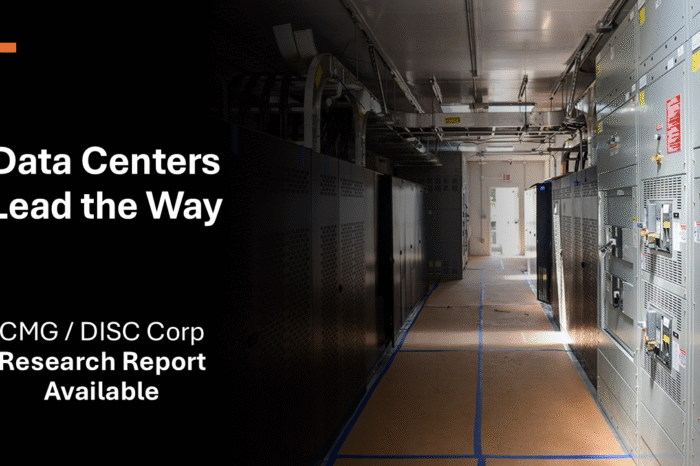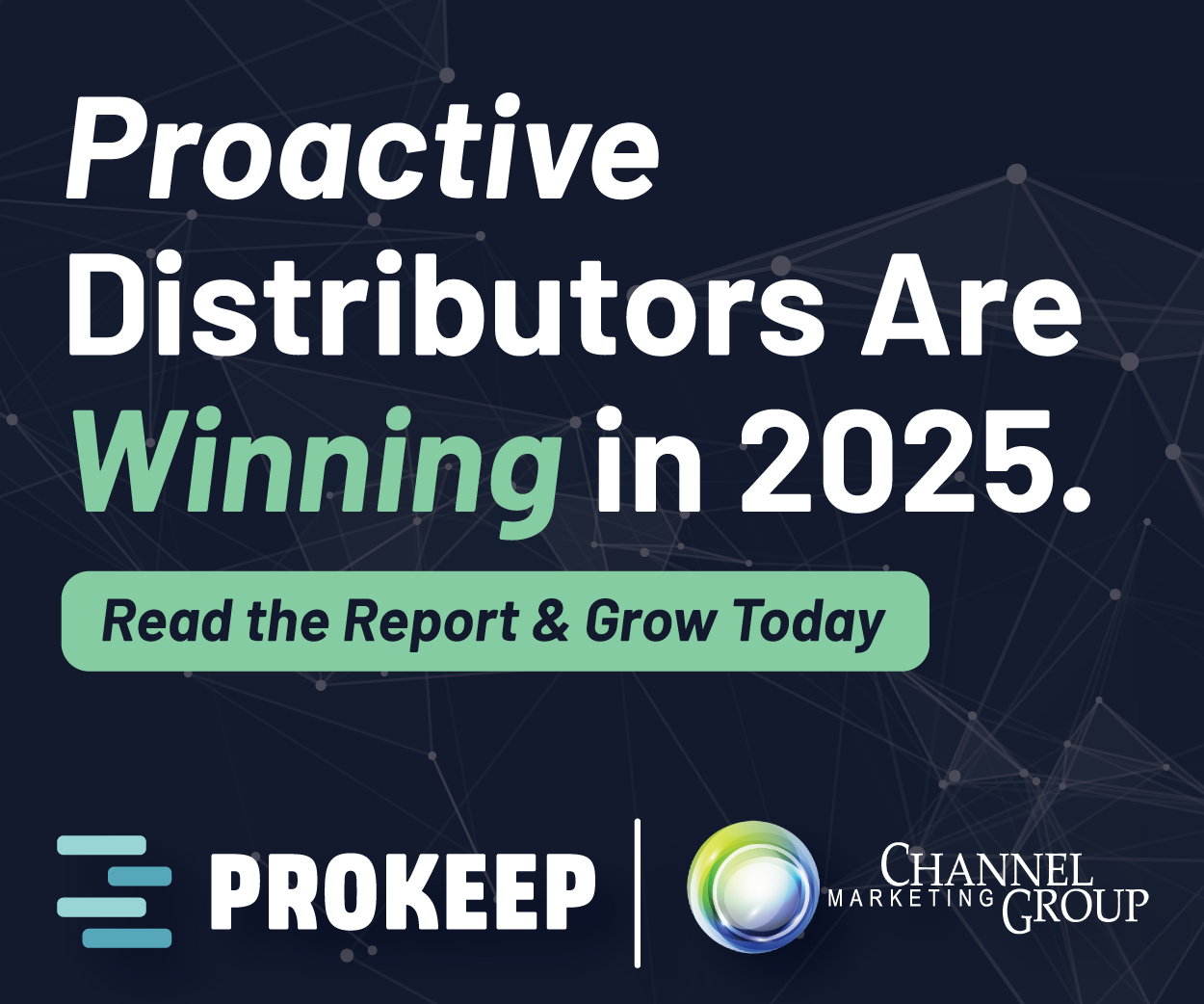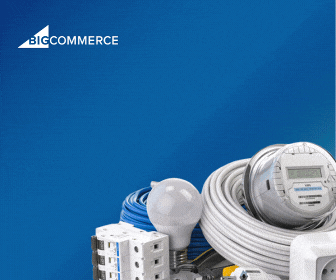nVent, Schneider, Legrand Earnings Reports – Data Centers
 Over the past few weeks I’ve been reading and reviewing industry quarterly earnings reports. Below are observations and key insights regarding nVent, Schneider Electric, and Legrand.
Over the past few weeks I’ve been reading and reviewing industry quarterly earnings reports. Below are observations and key insights regarding nVent, Schneider Electric, and Legrand.
nVent
The London, UK based designer and manufacturer of electrical connection and protective solutions, reported 2Q25 earnings on August 1. Sales from continuing operations were $963 million, up 30% year-over-year, up 9% organically. The surge in sales growth was underpinned by acquisitions, primarily EPG, which contributed $153 million during the quarter. Adjusted operating income rose 18% to $200 million.
Other highlights from the quarter include:
- Organic growth was led by Infrastructure, including data centers and power utilities
- All geographies grew organically >20% organic order growth year-over-year sequential backlog growth
- New products contributed >3 points to sales growth
Backlog reached record levels, with strong double-digit growth in orders and sales, fueled by acquisitions and robust demand in key infrastructure verticals (power utilities, data centers, renewables). Strong double-digit growth was cited in the Americas. Although nVent does not explicitly break out sales by geography, it is estimated that the Americas (primarily the US) account for approximately 70% of nVent’s sales.
For the remainder of 2025, nVent is focused on navigating tariff impacts with mitigating actions, becoming a more focused, higher growth electrical company driven by high-growth verticals and new products with the Infrastructure vertical leading growth driven by AI data centers. nVent raised sales guidance for the remainder of 2025 from 5% to 7% organic growth to 8% to 10% organic growth, citing strength across all geographies and end markets.
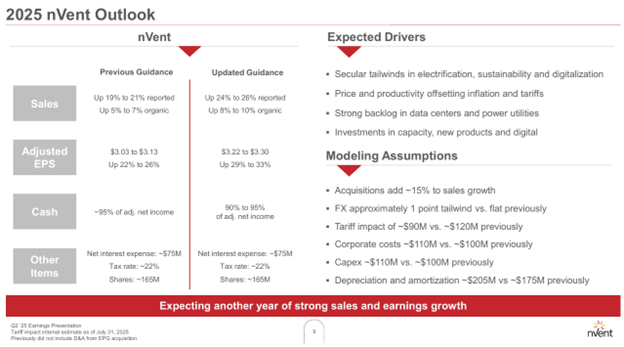
Despite the strong earnings, some concerns were raised by stakeholders during the earnings conference call.
nVent faced $35 million in inflation and tariff-related costs during the quarter. While management indicated that pricing actions and productivity initiatives largely offset these impacts, persistent inflation or additional tariff escalation could strain margins in future quarters.
Also, continued growth depends on successful integration of EPG, and on the sustainability of acquired growth versus organic performance, so a lot is riding on continued acquisition integration.
Cash flow issues were raised as free cash flow for the quarter fell to $74 million (down from $101 million in Q2 2024), mainly due to higher working capital investment to support growth initiatives. This could be a flag for investors if cash flow conversion continues to lag behind earnings, especially if nVent undertakes further expansion.
Is Q2’s growth repeatable, or if it’s partly driven by favorable near-term cycles (AI/data center build-out, renewable surge), could those trends normalize in the future?
Schneider Electric
The Rueil-Malmaison, France headquartered global electronics and industrial technology leader specializing in digital automation and energy management, announced first half results for 2025 on July 31 featuring revenue of €10.01 billion, up 8.3% organically. Gross profit margin of 42.4% was down 90 basis points organically compared to prior year.
By business segment, the Energy Management segment revenue was up 10.5% organically to €8 billion, while the Industrial Automation Segment revenue was down 1.1% to €2 billion organically, but showing signs of discrete recovery.
The Energy Management Segment focuses on low- and medium-voltage products, power distribution, digital energy, uninterruptible power supplies (UPS), switchgear, smart grid solutions, and building management systems. It also encompasses EcoStruxure—Schneider’s digital IoT platform for energy efficiency and sustainability.
The Industrial Automation Segment focuses on automation solutions and software for process and hybrid industries, machine automation, industrial control, drives, sensors, robotics, and digital factory solutions. Key end markets include manufacturing, process industries, machinery, transportation, water & wastewater, energy, and chemicals.
All four global regions reported growth, notably North America (38% of Q2 revenue) with 12.5% organic growth.
By end market, growth was driven by data centers, with strong headwinds in Infrastructure and Industry.
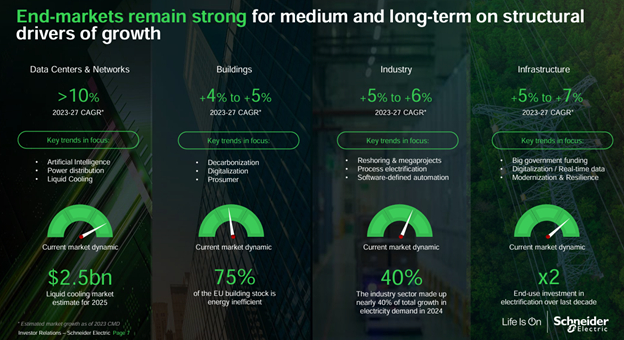
Schneider Electric demonstrated solid revenue growth, operational efficiency, and strategic momentum in Q2 2025, anchored by its electrification transition and investments in key growth sectors such as data centers and sustainable technologies.
The United States contributes approximately 38% of Schneider Electric’s total revenue as of Q2 2025. North America was the largest regional market for Schneider, with organic revenue growth of 12.5% in the quarter and 15% in the Energy Management Segment. The U.S. specifically experienced strong double-digit growth in Systems driven by the Data Center end-market and robust execution in the Buildings and Water & Wastewater sectors.
Additional details on the US Energy Management Segment include double-digit growth in U.S. led by Systems, up strong double-digit, primarily in Data Center supported by a large Building project and traction in WWW. Services in U.S. grew double-digit Product growth in U.S. up low-single digit with weakness in Residential partly offsetting good growth in other segments
The key drivers behind Schneider Electric’s confirmation of its 2025 outlook of organic revenue growth of 7% to 10%, include:
- Strong demand from data centers: The data center segment remains a standout growth driver, with double-digit sales growth in Q2 2025. Schneider’s advanced solutions, such as AI-powered Galaxy VXL UPS and liquid cooling systems (from its recently acquired Motivair), address critical power and cooling efficiency needs in AI and high-performance computing infrastructure.
- Growth in energy management: The energy management division reported a 10.5% organic revenue increase, driven by escalating electrification and industrial automation demand.
- Strategic investments in North America: Schneider is investing $700 million through 2027 to expand its footprint in the U.S., creating over 1,000 jobs. This includes new facilities and innovation centers aimed at supporting AI infrastructure and electrification growth
Schneider noted accelerated momentum as they enter the second half of 2025 and reaffirmed their guidance.
Concerns were raised around:
- Margin pressure and cost inflation – Despite the strong organic revenue growth, Schneider Electric experienced margin compression, partly due to foreign exchange headwinds and seasonal factors. Investors are wary about sustaining margin levels in an environment of pricing pressure and elevated costs
- Cost management and operational efficiency – shareholders expressed concerns around cost savings targets to offset inflation and competitive pressures
- While data centers and electrification remain key growth drivers, shareholders are cautious about the Industrial Automation segment’s slight organic decline and wanted clarity on recovery.
Legrand – Datacenter Continues to Drive Strong Sales
The Limoges, France headquartered global company specializing in electrical and digital building infrastructures through a range of high value-added products and solutions including lighting, controls, power management and transmission for commercial, industrial and residential applications, announced strong 1H 2025 results on July 31, after the brief unscheduled first half update to earnings on July 17.
Overall sales in the first half of 2025 in North and Central America grew 20.5% and in the second quarter grew 22%, suggesting momentum as the first half of the year progressed. North & Central America region increased sales 20.5%, fueled by very robust demand in commercial and especially datacenter applications. This region was the main driver of Legrand’s outperformance. Datacenter segment led growth and accounted for 24% of Legrand’s total sales. The US accounts for almost 40% of Legrand’s total revenue.
Legrand also increased their earnings outlook for 2H to between 10% and 12%, with organic growth contributing 5% to 10% globally. Enhanced regional strength in the Americas and continued datacenter momentum were cited as the primary reasons for the upward revision to guidance.
CEO Benoit Coquart stated “the period was marked by numerous growth initiatives, both organic — with many new product launches and commercial initiatives — and external, with the acquisition of six recognized specialists in the energy and digital transition markets announced, representing close to €200 million in additional full-year revenue.” All acquisitions were outside the US.
Take Aways
- Data centers, Data Centers, Data Centers.
- Acquisitions, Acquisitions, Acquisitions.
- North America, and specifically the US, is driving growth.
- Mention of the distributor? (and yes, Wall Street doesn’t care about channel.)






